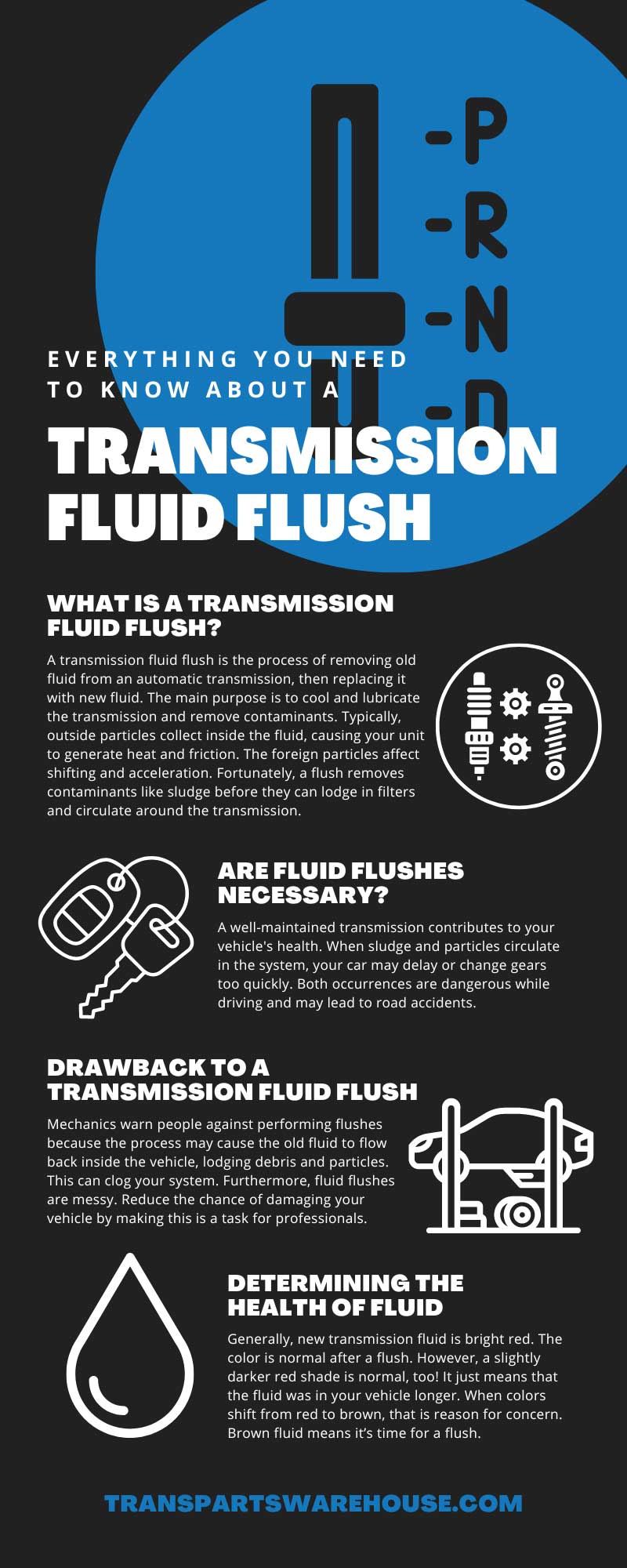
Vehicle performance relies on functioning internal parts. When something goes wrong, you compromise the vehicle’s harmony. In particular, transmission issues are an internal problem that you shouldn’t ignore. In cases of bad fluid, a fluid flush can improve your car. It’s important to understand the components that make up this service. That’s why everything you need to know about a transmission fluid flush is inside this guide!
What Is a Transmission Fluid Flush?
A transmission fluid flush is the process of removing old fluid from an automatic transmission, then replacing it with new fluid. The main purpose is to cool and lubricate the transmission and remove contaminants. Typically, outside particles collect inside the fluid, causing your unit to generate heat and friction. The foreign particles affect shifting and acceleration. Fortunately, a flush removes contaminants like sludge before they can lodge in filters and circulate around the transmission.
Replacing old liquid and working with high-quality fluid improves performance as your transmission runs cooler. Don’t worry about sludge deposits ruining your system by overheating your transmission. And for this service, visit a mechanic to receive a flush.
Are Fluid Flushes Necessary?
Routine transmission fluid flushes are necessary for any vehicle with an automatic transmission. They prevent internal damage like hydraulic line clogs and inner seal wear and tear. The flush decreases the chance of fluid leaks and restores lubrication.
A well-maintained transmission contributes to your vehicle's health. When sludge and particles circulate in the system, your car may delay or change gears too quickly. Both occurrences are dangerous while driving and may lead to road accidents.
Think of fluid flushes as preventative maintenance. Would you rather pay for a flush or a brand-new transmission? The cost-effective answer is a fluid flush. Don’t experience unnecessary damage when you can service your vehicle right.
How Does It Help Your Vehicle
Maximize the lifespan of your automatic transmission with a fluid flush. The new fluid lubricates the system and lets you move without harmful friction. The fluid itself keeps your vehicle on track and functioning right. Like any system, you must replace old components to enable the optimal performance. If you wait too long for a flush, you risk internal deterioration that’ll eventually lead to irreversible damage.
Is a Flush Similar to Changing Fluid?
Changing and flushing your transmission fluid are different things. Changing your fluid involves replacing 50-60 percent of the fluid. You drain the transmission pan and replace the filter. You also place new fluid inside the system. There’s a mixture of old and new fluid inside the vehicle.
On the other hand, a transmission flush replaces 100 percent of the old fluid and gets rid of accumulated sludge and deposits. Professionals use a cooler line flushing machine to pump fluid out of the vehicle. They also inspect, clean, and replace the filter. You the receive fresh automatic transmission fluid.
Many people assume that changing the fluid is enough to improve your system. While it removes some contaminants, your transmission still holds onto bad particles. With continuous changes, there’s no way to completely get rid of deposit. Fluid flushes offer a fresh start with pure fluid.
How Long Does a Fluid Flush Take?
A mechanic can perform a flush between three to four hours using the cooler line flushing machine. This is noticeably longer than the 30-minute process required to change fluid. However, a full flush ensures that all the bad fluid is out of your vehicle so that you can replace it with fresh liquid.
Drawback to a Transmission Fluid Flush
The main drawback to a fluid flush is the price. A transmission flush may range from $100-$400. This is also a job for professionals because it requires a flushing machine.
Mechanics warn people against performing flushes because the process may cause the old fluid to flow back inside the vehicle, lodging debris and particles. This can clog your system. Furthermore, fluid flushes are messy. Reduce the chance of damaging your vehicle by making this is a task for professionals.
Outside of price, there’s no reason to hesitate to get a transmission fluid flush. It helps your vehicle by removing bad contaminants.
Important Note
It’s critical to understand that a compromised transmission shouldn’t receive a flush. During the flushing process, too much force can lodge debris into different places and create further damage. Before undergoing a flush, inspect your transmission. Underlying problems need solutions.
Signs That You Need a Flush
It’s best to get a fluid flush every 30,000 miles (every two years). However, some vehicles require this service sooner than others. If you experienced transmission problems in the past, you know that a minor issue can quickly turn into a bad situation. That’s why it’s important to acknowledge the signs that you need a flush. Here are some indicators:
- You have issues shifting gears. In particular, your vehicle shifts too fast or too slow. Deposit buildup causes this to happen and it’s time for a flush.
- Dirty transmissions lack hydraulic power, making you slip gears. If you experience slipping, investigate the issue and get a fluid flush.
- You see dark red or brown fluid on your dipstick. Healthy fluid has a light red color. Dark shades indicate that contaminants are inside the fluid.
- Bad transmission fluid has similar symptoms to low fluid levels. In this case, grinding and odd noises may indicate contaminated fluid. While you check fluid levels, assess the liquid’s color. As mentioned, bad fluid is dark and sludge-like.
- If your vehicle stalls when you put it in gear, it may be time for a flush.
Determining the Health of Fluid
Generally, new transmission fluid is bright red. The color is normal after a flush. However, a slightly darker red shade is normal, too! It just means that the fluid was in your vehicle longer. When colors shift from red to brown, that is reason for concern. Brown fluid means it’s time for a flush. Schedule an appointment soon (within one to two weeks). A dark or black color indicates burnt or ineffective fluid. You need professional help as soon as possible. Don’t ignore dark transmission fluid or put off getting a flush. The service has a significant impact on your vehicle!
Now that you reviewed the things you need to know about a transmission fluid flush, be sure to receive this service every 30,000 miles or two years. New fluid improves lubrication and performance. Speaking of performance, do you want to enhance or repair your vehicle? If so, Transparts Warehouse has the products you need. As the top automatic transmission parts supplier, we carry affordable wholesale parts. Please browse our website today!



